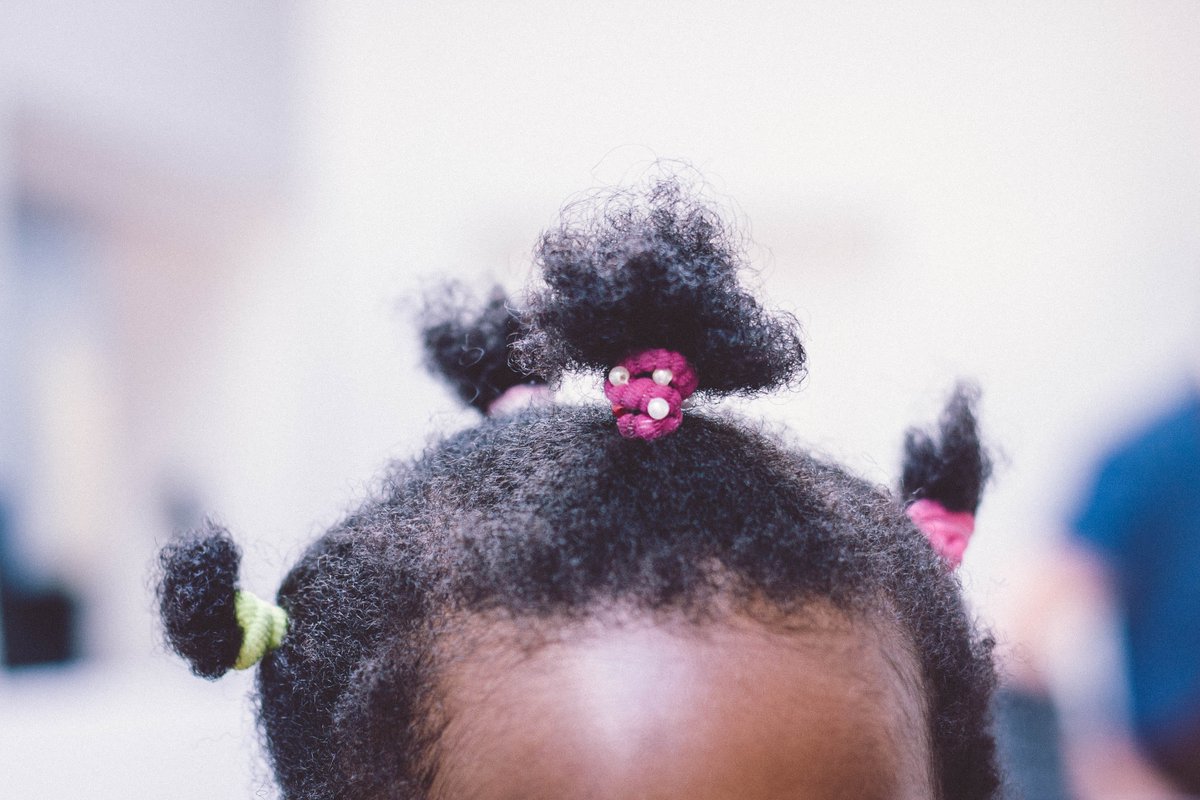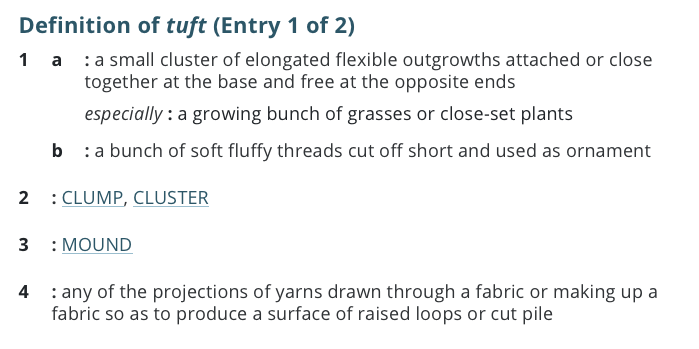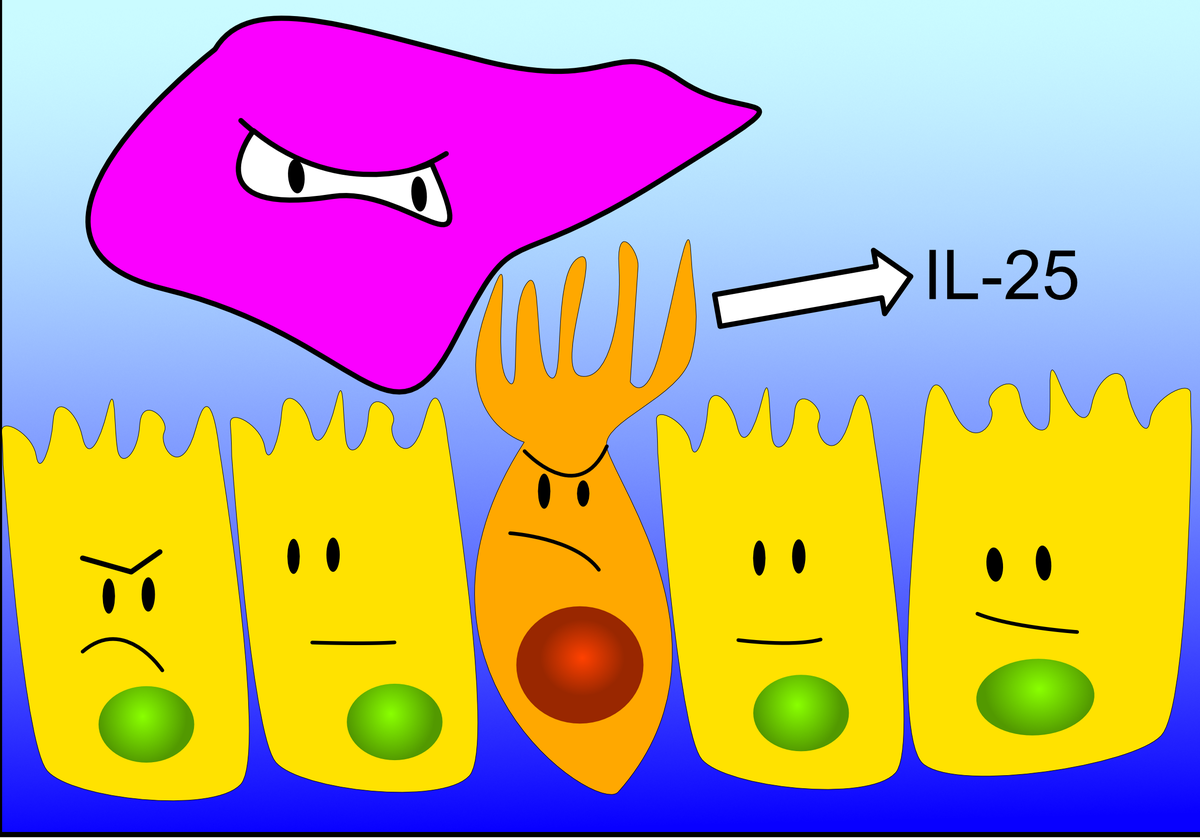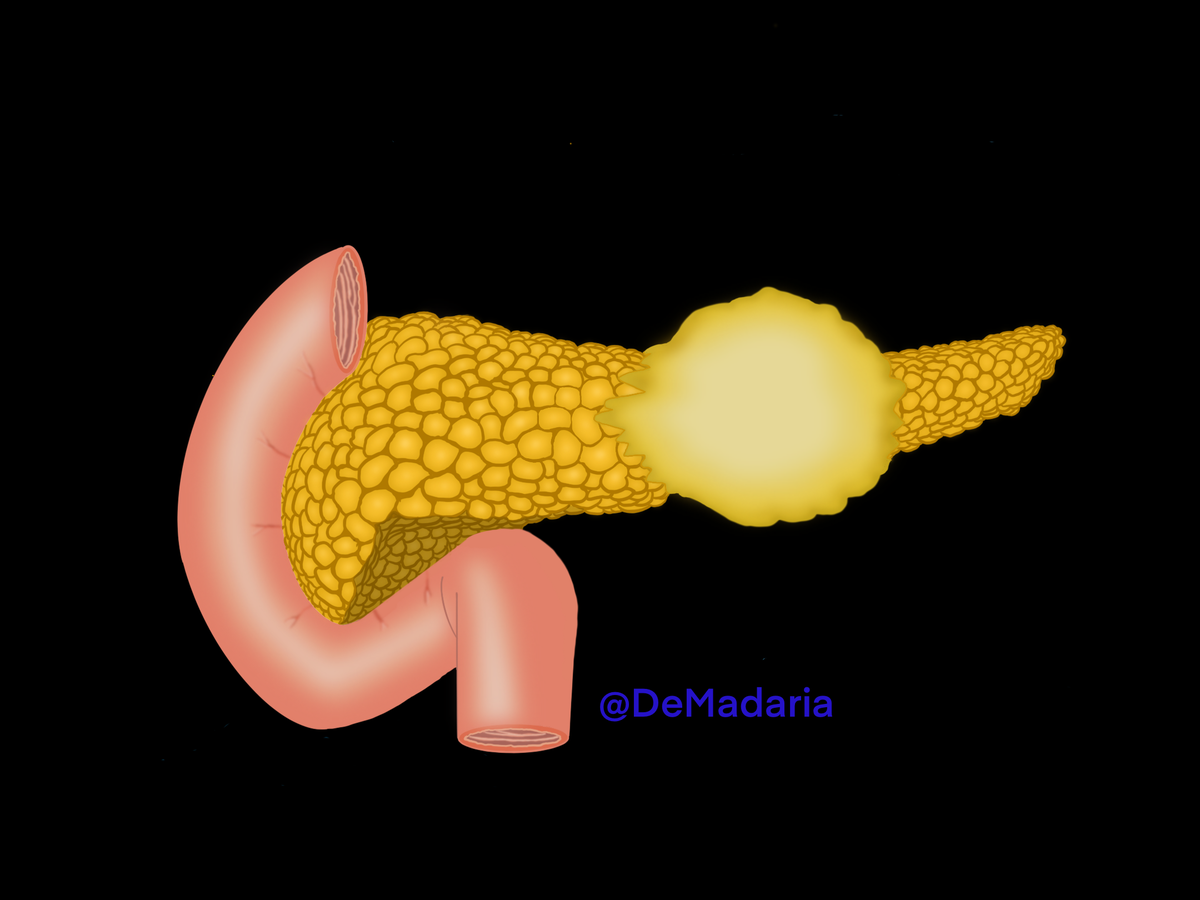Recently @DelgiornoKathy & Cols have published a paper on @AGA_Gastro @AmerGastroAssn about tuft cells and their relationship with pancreatic cancer #PancreasTwitter
What are pancreatic tuft cells? Don& #39;t miss this #UEGambassador thread @my_ueg
 https://abs.twimg.com/emoji/v2/... draggable="false" alt="👇" title="Rückhand Zeigefinger nach unten" aria-label="Emoji: Rückhand Zeigefinger nach unten">
https://abs.twimg.com/emoji/v2/... draggable="false" alt="👇" title="Rückhand Zeigefinger nach unten" aria-label="Emoji: Rückhand Zeigefinger nach unten"> https://abs.twimg.com/emoji/v2/... draggable="false" alt="👇" title="Rückhand Zeigefinger nach unten" aria-label="Emoji: Rückhand Zeigefinger nach unten">
https://abs.twimg.com/emoji/v2/... draggable="false" alt="👇" title="Rückhand Zeigefinger nach unten" aria-label="Emoji: Rückhand Zeigefinger nach unten"> https://abs.twimg.com/emoji/v2/... draggable="false" alt="👇" title="Rückhand Zeigefinger nach unten" aria-label="Emoji: Rückhand Zeigefinger nach unten">
https://abs.twimg.com/emoji/v2/... draggable="false" alt="👇" title="Rückhand Zeigefinger nach unten" aria-label="Emoji: Rückhand Zeigefinger nach unten">
https://doi.org/10.1053/j.gastro.2020.07.037">https://doi.org/10.1053/j...
What are pancreatic tuft cells? Don& #39;t miss this #UEGambassador thread @my_ueg
https://doi.org/10.1053/j.gastro.2020.07.037">https://doi.org/10.1053/j...
All this thread is based on @DelgiornoKathy & Cols paper: https://doi.org/10.1053/j.gastro.2020.07.037
First">https://doi.org/10.1053/j... of all, for non-English speaking #PancreaticLovers,
a tuft is....
 https://abs.twimg.com/emoji/v2/... draggable="false" alt="👇" title="Rückhand Zeigefinger nach unten" aria-label="Emoji: Rückhand Zeigefinger nach unten">
https://abs.twimg.com/emoji/v2/... draggable="false" alt="👇" title="Rückhand Zeigefinger nach unten" aria-label="Emoji: Rückhand Zeigefinger nach unten"> https://abs.twimg.com/emoji/v2/... draggable="false" alt="👇" title="Rückhand Zeigefinger nach unten" aria-label="Emoji: Rückhand Zeigefinger nach unten">
https://abs.twimg.com/emoji/v2/... draggable="false" alt="👇" title="Rückhand Zeigefinger nach unten" aria-label="Emoji: Rückhand Zeigefinger nach unten"> https://abs.twimg.com/emoji/v2/... draggable="false" alt="👇" title="Rückhand Zeigefinger nach unten" aria-label="Emoji: Rückhand Zeigefinger nach unten">
https://abs.twimg.com/emoji/v2/... draggable="false" alt="👇" title="Rückhand Zeigefinger nach unten" aria-label="Emoji: Rückhand Zeigefinger nach unten">
(in Spanish: mechón)
First">https://doi.org/10.1053/j... of all, for non-English speaking #PancreaticLovers,
a tuft is....
(in Spanish: mechón)
Tuft cells are chemoreceptors. They like to be alone, in the hollow organs, particularly in the respiratory and digestive systems. Their long gorgeous microvilli make tuft cells very cool. We think they are involved in monitoring intraluminal homeostasis https://link.springer.com/article/10.1111/j.1447-073X.2007.00188.x">https://link.springer.com/article/1...
Recent studies in parasitic infections and experiments with thymic tuft cells suggest that tuft cells work detect inflammation and react modulating it.
According to Ting et al in an open-access review "tuft cells use chemosensing to monitor their surroundings and translate environmental signals into effector functions that regulate immune responses in the underlying tissue" https://www.jimmunol.org/content/202/5/1321">https://www.jimmunol.org/content/2...
Pancreatic ductal adenocarcinoma (PDAC) is a very aggressive tumor, a perfect enemy that grows quietly, expands quickly and is resistant to chemo and radiotherapy.
Pancreatic acinar cells change in appearance in response to injury, becoming closer to ductal cells, this is called acinar to ductal metaplasia (ADM). BUT when KRAS mutation happens, ADM may evolve to pancreatic intraepithelial neoplasia (PanIN) and then to PDAC
Several papers, including some from @DelgiornoKathy & #39;s group suggest that tuft cells come from acinar cells exposed to stress (injury -pancreatitis in example-, KRAS expression, development of PanIN), as part of the ADM process @FrontiersIn https://www.frontiersin.org/articles/10.3389/fphys.2020.00088/full">https://www.frontiersin.org/articles/...
BUT (and this is quite important) they are not frequently present in PDAC
@DelgiornoKathy & Cols wanted to describe the role of tuft cells in PDAC tumorigenesis. For that purpose, they performed an ablation of Pou2f3. As you are not experts in tuft cells like her, you must know that Pou2f3 is a tuft cell master regulator https://doi.org/10.1053/j.gastro.2020.07.037">https://doi.org/10.1053/j...
They describe in their @AGA_Gastro paper that Pou2f3 ablation results in the prevention of tuft cell formation, and they showed that the absence of these awesome cells ACCELERATES tumorigenesis: they are protective against one of our worst enemies
So do not make a self-ablation of your own Pou2f3
They investigated how tuft cells protect us from PDAC and they found that these cells seem to secrete suppressive eicosanoids such as protaglandin D2 helping to maintain pancreatic homeostasis and attenuation of disease progression
So, @DelgiornoKathy thanks for helping us to know more about this interesting field, and for showing us the tuft cells, which confess I knew nothing about until I followed your work!
If you liked this twitter thread, just retweet the first tweet and congratulate @DelgiornoKathy
By the way Kathy, I am a clinician, sorry if I had some mistakes
By the way Kathy, I am a clinician, sorry if I had some mistakes

 Read on Twitter
Read on Twitter https://abs.twimg.com/emoji/v2/... draggable="false" alt="👇" title="Rückhand Zeigefinger nach unten" aria-label="Emoji: Rückhand Zeigefinger nach unten">https://abs.twimg.com/emoji/v2/... draggable="false" alt="👇" title="Rückhand Zeigefinger nach unten" aria-label="Emoji: Rückhand Zeigefinger nach unten"> https://doi.org/10.1053/j..." title="Recently @DelgiornoKathy & Cols have published a paper on @AGA_Gastro @AmerGastroAssn about tuft cells and their relationship with pancreatic cancer #PancreasTwitterWhat are pancreatic tuft cells? Don& #39;t miss this #UEGambassador thread @my_ueg https://abs.twimg.com/emoji/v2/... draggable="false" alt="👇" title="Rückhand Zeigefinger nach unten" aria-label="Emoji: Rückhand Zeigefinger nach unten">https://abs.twimg.com/emoji/v2/... draggable="false" alt="👇" title="Rückhand Zeigefinger nach unten" aria-label="Emoji: Rückhand Zeigefinger nach unten">https://abs.twimg.com/emoji/v2/... draggable="false" alt="👇" title="Rückhand Zeigefinger nach unten" aria-label="Emoji: Rückhand Zeigefinger nach unten"> https://doi.org/10.1053/j..." class="img-responsive" style="max-width:100%;"/>
https://abs.twimg.com/emoji/v2/... draggable="false" alt="👇" title="Rückhand Zeigefinger nach unten" aria-label="Emoji: Rückhand Zeigefinger nach unten">https://abs.twimg.com/emoji/v2/... draggable="false" alt="👇" title="Rückhand Zeigefinger nach unten" aria-label="Emoji: Rückhand Zeigefinger nach unten"> https://doi.org/10.1053/j..." title="Recently @DelgiornoKathy & Cols have published a paper on @AGA_Gastro @AmerGastroAssn about tuft cells and their relationship with pancreatic cancer #PancreasTwitterWhat are pancreatic tuft cells? Don& #39;t miss this #UEGambassador thread @my_ueg https://abs.twimg.com/emoji/v2/... draggable="false" alt="👇" title="Rückhand Zeigefinger nach unten" aria-label="Emoji: Rückhand Zeigefinger nach unten">https://abs.twimg.com/emoji/v2/... draggable="false" alt="👇" title="Rückhand Zeigefinger nach unten" aria-label="Emoji: Rückhand Zeigefinger nach unten">https://abs.twimg.com/emoji/v2/... draggable="false" alt="👇" title="Rückhand Zeigefinger nach unten" aria-label="Emoji: Rückhand Zeigefinger nach unten"> https://doi.org/10.1053/j..." class="img-responsive" style="max-width:100%;"/>
 https://abs.twimg.com/emoji/v2/... draggable="false" alt="👇" title="Rückhand Zeigefinger nach unten" aria-label="Emoji: Rückhand Zeigefinger nach unten">https://abs.twimg.com/emoji/v2/... draggable="false" alt="👇" title="Rückhand Zeigefinger nach unten" aria-label="Emoji: Rückhand Zeigefinger nach unten">(in Spanish: mechón)" title="All this thread is based on @DelgiornoKathy & Cols paper: https://doi.org/10.1053/j... of all, for non-English speaking #PancreaticLovers, a tuft is....https://abs.twimg.com/emoji/v2/... draggable="false" alt="👇" title="Rückhand Zeigefinger nach unten" aria-label="Emoji: Rückhand Zeigefinger nach unten">https://abs.twimg.com/emoji/v2/... draggable="false" alt="👇" title="Rückhand Zeigefinger nach unten" aria-label="Emoji: Rückhand Zeigefinger nach unten">https://abs.twimg.com/emoji/v2/... draggable="false" alt="👇" title="Rückhand Zeigefinger nach unten" aria-label="Emoji: Rückhand Zeigefinger nach unten">(in Spanish: mechón)">
https://abs.twimg.com/emoji/v2/... draggable="false" alt="👇" title="Rückhand Zeigefinger nach unten" aria-label="Emoji: Rückhand Zeigefinger nach unten">https://abs.twimg.com/emoji/v2/... draggable="false" alt="👇" title="Rückhand Zeigefinger nach unten" aria-label="Emoji: Rückhand Zeigefinger nach unten">(in Spanish: mechón)" title="All this thread is based on @DelgiornoKathy & Cols paper: https://doi.org/10.1053/j... of all, for non-English speaking #PancreaticLovers, a tuft is....https://abs.twimg.com/emoji/v2/... draggable="false" alt="👇" title="Rückhand Zeigefinger nach unten" aria-label="Emoji: Rückhand Zeigefinger nach unten">https://abs.twimg.com/emoji/v2/... draggable="false" alt="👇" title="Rückhand Zeigefinger nach unten" aria-label="Emoji: Rückhand Zeigefinger nach unten">https://abs.twimg.com/emoji/v2/... draggable="false" alt="👇" title="Rückhand Zeigefinger nach unten" aria-label="Emoji: Rückhand Zeigefinger nach unten">(in Spanish: mechón)">
 https://abs.twimg.com/emoji/v2/... draggable="false" alt="👇" title="Rückhand Zeigefinger nach unten" aria-label="Emoji: Rückhand Zeigefinger nach unten">https://abs.twimg.com/emoji/v2/... draggable="false" alt="👇" title="Rückhand Zeigefinger nach unten" aria-label="Emoji: Rückhand Zeigefinger nach unten">(in Spanish: mechón)" title="All this thread is based on @DelgiornoKathy & Cols paper: https://doi.org/10.1053/j... of all, for non-English speaking #PancreaticLovers, a tuft is....https://abs.twimg.com/emoji/v2/... draggable="false" alt="👇" title="Rückhand Zeigefinger nach unten" aria-label="Emoji: Rückhand Zeigefinger nach unten">https://abs.twimg.com/emoji/v2/... draggable="false" alt="👇" title="Rückhand Zeigefinger nach unten" aria-label="Emoji: Rückhand Zeigefinger nach unten">https://abs.twimg.com/emoji/v2/... draggable="false" alt="👇" title="Rückhand Zeigefinger nach unten" aria-label="Emoji: Rückhand Zeigefinger nach unten">(in Spanish: mechón)">
https://abs.twimg.com/emoji/v2/... draggable="false" alt="👇" title="Rückhand Zeigefinger nach unten" aria-label="Emoji: Rückhand Zeigefinger nach unten">https://abs.twimg.com/emoji/v2/... draggable="false" alt="👇" title="Rückhand Zeigefinger nach unten" aria-label="Emoji: Rückhand Zeigefinger nach unten">(in Spanish: mechón)" title="All this thread is based on @DelgiornoKathy & Cols paper: https://doi.org/10.1053/j... of all, for non-English speaking #PancreaticLovers, a tuft is....https://abs.twimg.com/emoji/v2/... draggable="false" alt="👇" title="Rückhand Zeigefinger nach unten" aria-label="Emoji: Rückhand Zeigefinger nach unten">https://abs.twimg.com/emoji/v2/... draggable="false" alt="👇" title="Rückhand Zeigefinger nach unten" aria-label="Emoji: Rückhand Zeigefinger nach unten">https://abs.twimg.com/emoji/v2/... draggable="false" alt="👇" title="Rückhand Zeigefinger nach unten" aria-label="Emoji: Rückhand Zeigefinger nach unten">(in Spanish: mechón)">





